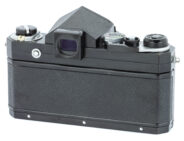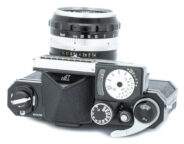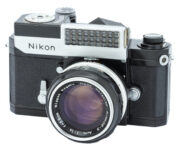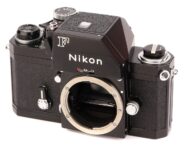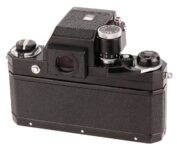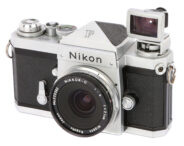Announced
Production status
System
Nikon F system cameras
- Nikkorex F
- Nikkormat EL
- Nikkormat ELW
- Nikkormat FS
- Nikkormat FT
- Nikkormat FT2
- Nikkormat FT3
- Nikkormat FTN
- Nikon D3
- Nikon D3s
- Nikon D3X
- Nikon D4
- Nikon D4s
- Nikon D5
- Nikon D6
- Nikon D600
- Nikon D610
- Nikon D700
- Nikon D750
- Nikon D780
- Nikon D800
- Nikon D800E
- Nikon D810
- Nikon D850
- Nikon Df
- Nikon EL2
- Nikon EM
- Nikon F
- Nikon F100
- Nikon F2
- Nikon F3
- Nikon F4
- Nikon F5
- Nikon F6
- Nikon FA
- Nikon FE
- Nikon FE10
- Nikon FE2
- Nikon FG
- Nikon FG-20
- Nikon FM
- Nikon FM10
- Nikon FM2
- Nikon FM2/T
- Nikon FM3A
- Nikon N2000
- Nikon N2020
- Nikon N4004
- Nikon N4004S
- Nikon N50
- Nikon N5005
- Nikon N55
- Nikon N60
- Nikon N6000
- Nikon N6006
- Nikon N65
- Nikon N70
- Nikon N75
- Nikon N80
- Nikon N8008
- Nikon N8008S
- Nikon N90
- Nikon N90S
Nikon F
35mm MF film SLR camera • Discontinued
Specification
| Format: | |
| 35mm full frame | |
Film type: | 135 cartridge-loaded film |
| Nikon F [46.5mm] | |
| Shutter: | |
Type: | Focal-plane |
Model: | Mechanical |
Speeds: | 1 - 1/1000 + B |
| Exposure: | |
Exposure metering: | None |
Exposure modes: | Manual |
| Physical characteristics: | |
Weight: | 1010g |
Dimensions: | 147x98x101mm |
Manufacturer description #1
There are many reasons why the Nikon F is the fastest selling big ticket 35mm camera, today.
Its remarkably brilliant finder and its extraordinary ease of handling by themselves distinguish the Nikon from other fine 35mm reflex cameras.
But in addition, the Nikon F offers more automatic features, more design innovations, more lenses - all Nikkors (ranging from 8mm super wide angle through 1000mm super tele-photo), and a wider range of unique accessories, than any other camera. For example, the Dealer can sell the Nikon F with the remarkable new Photomic Finder (Nikon F Photomic) which incorporates a meter and prism finder in the same housing, or he can sell the Nikon F with the conventional prism finder, and have the opportunity to sell the Photomic finder, or the conventional meter, afterwards.
The performance and durability of the Nikon F have been proved under the most demanding conditions 'man shoots' and satellite launchings, while attached to speed boats, racing cars and planes, in extremes of heat and cold. It has withstood the incredible demands of continuous motor operation - a performance matched by no other 35mm camera.
Today the Nikon F is the '35' used by more Professional, Scientific and Industrial photographers than any other camera. And it presents the Dealer with more opportunities for profitable lens and accessory sales.
NIKON "F" AUTOMATIC REFLEX CAMERA - 35mm; 36 exposure, 1 x 1 1/2 Available with interchangeable Photomic finder (Nikon F Photomic) - combining a meter and prism finder in one housing - or a conventional pentaprism eyelevel finder. Features instant return automatic mirror and instant reopen automatic diaphragm; built-in depth of field preview control; built-in ground glass rangefinder - interchangeable with standard ground glass. Provision for locking mirror up; accepts diaphragm and shutter coupled exposure meter; electric motor drive. Accepts accessory waist level finder; 13 shutter speeds, click-stop, from 1 to 1/1000 plus T & B, on single non-rotating dial; full synch plus electronic flash at 1/60; auto zero reset exposure counter; calibrated, delayed action self timer; removable back; fixed take up spool; single stroke rapid film advance; high speed film rewind; tripod socket built into camera body.
INTERCHANGEABLE FINDERS AND FOCUSING SCREENS
Eye-level photomic finder (meter and prism in one housing) provides full size image of the entire field even when wearing glasses. Interchanges with pentaprism finder or with accessory waist-level hood and magnifier. Finder field coincides precisely with film area - covers 100% of the image as it will record on the film.
Convex, lenticular focusing ground glass gives maximum and uniform brightness over the entire field. Has built-in prismatic, split-image rangefinder as a further aid to precise focusing. Interchanges easily with other types of Nikon ground glasses.
INSTANT- RETURN AUTOMATIC MIRROR
Whisper-quiet, lightning fast-the mirror returns to precise focusing-viewing position the instant the exposure is made, even with the camera held upside down. A special, patented brake helps eliminate vibration from the mirror's action.
INSTANT-REOPEN AUTOMATIC DIAPHRAGM
Focus and view with the lens wide open. At the instant of exposure, the diaphragm automatically closes down to 'taking' aperture. Then, instantly, automatically it reopens again to full aperture. So unique is the design of the Nikon automatic diaphragm that even when pre-set for intermediate openings-between markings - the action of the diaphragm will not disturb the setting. When interchanging lenses, no attention need be paid as to whether or not the shutter had been previously wound. The diaphragm is fully automatic and foolproof.
INSTANT-ACTION PREVIEW CONTROL
Press the Preview Control button, and the diaphragm stops down. Permits you to see the depth-of-field at 'taking' aperture - or to select 'taking' aperture on the basis of desired depth-of-field. Release the button, and the diaphragm reopens instantly. The Preview Control is independent of the shutter release mechanism, and cannot cause accidental exposure.
Manufacturer description #2
- 35mm single lens reflex camera.
- Picture size: 24mmx36mm.
- Interchangeable Eye-Level finder with penta-prism supplied as standard equipment.
- Interchangeable type A focusing screen supplied as standard fitment. Vibration-free, automatic instant return mirror which can be placed in locked up position.
- Focal plane shutter using ball bearing and titanium foil curtain.
- Built-in calibrated self-timer.
- Flash synchronization for all speeds up to 1/1000 sec., with provisions for electronic flash up to 1/60 sec.
- Press button type depth of field preview control.
- Instant reopening automatic diaphragm, closes to preselected "taking" aperture at instant of exposure: automatically reopens to full aperture.
- Bayonet lens mount.
- Self-resetting type exposure counter. Film winding by single stroke lever which also cocks the shutter and operates the exposure counter.
- Rapid film rewinding crank which folds down when not in use.
- Detachable camera back which is interchangeable with Motor Drive Back.
- Fixed take-up spool.
- Tripod socket in body casting
- Accepts Model 3 Nikon exposure meter
- ASA ratings from 6 to 4,000.
Nikon F Photomic-T
With exception of the following, all other specifications remain exactly the same as in Nikon F.
- Interchangeable Photomic-T finder supplied as standard equipment.
- Film speeds range from ASA 25 to 6,400.
- Dimensions: 147mm x 103mm x 101mm with 50mm f/1.4 lens.
- Weight: body without lens 830 g (1.8 lbs.), body with 50mm f/1.4 lens 1,155 g (2.5 lbs.).
Manufacturer description #3
The Nikon F is a 35 mm single lens reflex precision camera. It inherits numerous proven features of the Nikon S-series rangefinder model, and also incorporates abundant outstanding mechanisms and advantages which have been originated and developed for the most advanced single lens reflex. These unique features and functions originated by Nikon include:
Inherited from Nikon S-series rangefinder model:
- Crank-type film rewinding lever.
- Film advance lever enabling winding in a single sweep or several short strokes.
- Titanium foil shutter curtain.
- Shutter mechanism utilizing ball bearing and steel friction balls.
- Color-coded flash synchronization system.
- Synchronization terminal accepting cordless flash.
- Regular camera back that is interchangeable with Motor Drive back.
Specially originated for Nikon F:
- Interchangeable through-the-Iens meter/finder system.
- Depth of field preview control.
- Mirror lock-up.
- Interchangeable viewfinders and focusing screens.
- Exposure meter coupled to both shutter speed and diaphragm aperture through the meter coupling prong.
- Color-coded depth of field scale on Nikkor lenses.
The camera body is composed of 918 pieces. These parts are precisely designed, processed, finished and assembled and are subject to strict inspections to bring out the matchless performance of the Nikon F camera.
Manufacturer description #4
The new Photomic T brings 'thru-the-Nikkor' exposure control to the Nikon F, and provides the user with another logical choice of interchangeable finder systems.
'Thru-the-Nikkor' exposure control goes far beyond the idea of just another thru-the-lens meter system. By linking the performance of the Nikkor lenses with the performance of the new Photomic T, it brings as much assurance of picture quality as of exposure accuracy.
Affixed to the Nikon F, the Photomic T measures subject brightness directly from the viewing screen. It employs two CdS cells, located in the prism housing. They 'see' only the framed-in picture area on the screen.
Each cell is equipped with a 2-lens optical system which excludes light rays coming from any angle outside the picture area. Furthermore, the finder prism is 'black' coated to eliminate surface reflections. Every precaution has been taken to prevent extraneous light from reaching these cells and upsetting the accuracy of the readings.
The Photomic T is cross-coupled to the shutter and aperture rings, but its operation does not interfere with automatic diaphragm action. The lens remains wide open for viewing and focusing at all times. It only stops down when the shutter is released, and then instantly reopens. The meter needle is visible in the finder and in the meter window on the Photomic T housing.
Nikon F camera bodies now in use require some modification to permit interchanging present finders with the Photomic T.
Manufacturer description #5
2 thru the-lens meter systems:
* full-screen * narrow-angle
Such is the versatility of the Nikon F that it provides not one, but two interchangeable thru-the-lens meter systems: the Photomic T for full-area measurements and the new Photomic TN for narrow-angle readings.
The Photomic T measures the brightness of the entire scene as it appears on the viewing screen. Its angle of acceptance is the same as the lens in use.
The new Photomic TN permits selective brightness measurements of small areas of the scene, as represented by the image in the 12mm diameter center spot found on most Nikon F viewing screens. This acceptance angle is less than 1/3 that of the lens: about 13° with the 50mm lens; about 4° with 200mm tele, etc.
Both Photomic systems are cross-coupled for full-aperture operation, thus retaining all the advantages of automatic diaphragm lenses. Both also permit stop-down or shooting-aperture readings, where desired. And both handle film speeds from ASA 25 to 6400.
The meter needle, in each case, is visible in the finder as well as in the window on the prism housing. Both are identical in appearance, except for the battery test button on the Photomic TN. Initially, the Photomic TN will be supplied with Nikon F cameras only. It will be available separately later, for use on all cameras that accept the Photomic T.
Photomic T or Photomic TN, the choice is yours with the Nikon F. Or, you can use both interchangeably. You switch meters - not cameras. Isn't this what versatility is all about?
Manufacturer description #6
In 1965, the Photomic T brought thru-the-lens exposure control to the Nikon F. It was a unique system. It could be used with any Nikon, and it interchanged with all finders. It permitted wide-open readings with auto-diaphragm Nikkors as well as stop-down readings with non-automatic lenses, or when using extension tubes, bellows, etc.
Like most other meters, it averaged scene brightness. But while averaging meters are reliable in normal situations, they tend to introduce incorrect readings with backlighted scenes, or where subjects are contrasted against brilliant backgrounds. Something had to be done.
Nikon ruled out the spot method (used by some manufacturers) because selection of the target area to be measured is extremely critical. Choosing the wrong area will invariably produce incorrect exposure.
The idea of a built-in choice of spot or average readings would only add operating complications, without eliminating the objections. And this would be unacceptable in a camera which had gained much of its reputation for speed and ease of handling.
Early in 1967, Nikon introduced the Photomic TN, the self-compensating center-weighted system. While it measured the brightness of the entire screen, more than 60% of its response sensitivity was concentrated in the central subject area.
It was a totally new approach. And its practical ability to deal even with difficult light conditions became immediately evident The rest is history.
The new Photomic FTN is the next logical development. It makes full use of the center-weighted principle, the facility for wide-open and stop-down measurements, and all the other earlier features. In addition, it offers: automatic ASA/lens-aperture indexing, which eliminates the need to reset the film speed when interchanging lenses; extended film speed range (ASA 6 to 6400); intermediate settings to compensate for transmission differences in certain special viewfinder screens; visible shutter-speed setting in finder; 2-second and 4-second exposure readings where required; and "on/off" meter switch which also functions as battery test button. Another FTN innovation is the pincer-type clamp which secures it snugly to the camera body.
Initially, the Photomic FTN head will be supplied with cameras only. Its availability as an interchangeable accessory is anticipated early in 1969. The FTN was designed for use with any Nikon F. However, cameras bearing serial numbers below 6900001 will require some adaptation.
From the editor
The following versions of the Nikon F were offered:
- Nikon F (1959) - a standard model with conventional pentaprism eye-level finder;
- Nikon F Photomic (1962) - as F, but with interchangeable Photomic eye-level finder, combining a window meter and prism finder in one housing;
- Nikon F Photomic T (1965) - as F, but with interchangeable Photomic-T eye-level finder with built-in TTL exposure meter;
- Nikon F Photomic TN (1967) - as F, but with interchangeable Photomic-TN eye-level finder with built-in TTL exposure meter and center-weighted metering;
- Nikon F Photomic FTN (1968) - as F, but with interchangeable Photomic-FTN eye-level finder with built-in TTL exposure meter and center-weighted metering. Shutter speeds displayed in the finder.
***
The weight and dimensions are indicated for the camera body with the Nikkor-S Auto 50mm F/1.4 lens mounted.
Similar cameras (4)
35mm full frame • Manual focus • Film • Singe-lens reflex • Nikon F mount
| Model | Shutter | Metering | Modes | Year |
|---|---|---|---|---|
| Kiev-17 aka Киев-17 |
M, 1/1000 | -- | M | 1978 ● |
| Kiev-19 aka Киев-19 |
M, 1/500 | TTL • WA | M | 1985 ● |
| Kiev-19M aka Киев-19М |
M, 1/500 | TTL • OA | M | 1988 ● |
| Kiev-20 aka Киев-20 |
M, 1/1000 | TTL • OA | M | 1983 ● |

